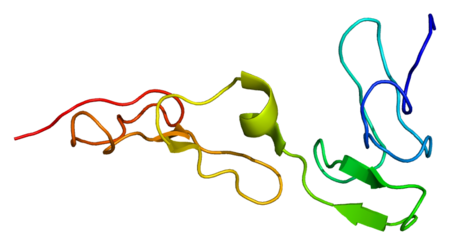
Protein S is named for Seattle, Washington, where the protein was first identified and isolated. Protein S is involved in the process of programmed cell death. This is a normal process in which a deficiency in the synthesis of Protein S can lead to severe thromboembolism and other pathologies. Furthermore, recent studies have revealed the interactions of Protein S in other chemical networks.
A Complex Molecule
Protein S is a vitamin K-dependent glycoprotein that is synthesized by hepatocytes in the liver. It contains a vitamin K-dependent carboxylation/gamma-carboxyglutamic (GLA) domain that allows it to bind calcium ions. It also has several EGF-like domains that are connected to the GLA by disulfide bonds (1). Protein S can also be synthesized by endothelial cells and megakaryocytes, where its activity is triggered by vitamin K-dependent gamma-carboxylation (1).
In humans, Protein S can be found free or attached to the complement component C4b-binding protein (C4b-BP). The C4b-BP is a glycoprotein that binds apoptotic and necrotic cells, and whose activity is mediated and regulated by the interaction with Protein S (2). Additionally, Protein S is involved in the removal of cells in the apoptotic state by stimulating activity of phagocytes. Protein S levels increase with age, which goes hand in hand with the increase of C4b-BP synthesis (2).
Free Protein S operates as a cofactor for Protein C, a polypeptide associated with the inhibition of procoagulant factors Va and VIIa (1). Protein analysis methods have revealed that this interaction reduces the generation of thrombin, a serine protease that plays a pivotal role in coagulation and is responsible for the conversion of fibrinogen into insoluble fibrin (3). C4b-BP can bind to Protein S, resulting in a reduction in the activity of Protein S as a cofactor for activated Protein C (2). Furthermore, Protein S can inhibit prothrombin activation.
Types of Protein S Deficiency
Protein S deficiency is a rare disease that has been shown to cause venous and arterial thrombosis. The gene responsible for the expression of Protein S, named PRO1, is located in chromosome 3. Mutations in PRO1 can cause an autosomal dominant condition that affects the levels of Protein S and can be divided into three types (4):
Type 1 deficiency is characterized by the reduction of all of the different forms of Protein S and its functions. It is the most frequently inherited deficiency. Missense or nonsense mutations are generally responsible for this pathology (5).
Type 2 deficiency, a rare pathology, is determined by the decrease of the functions of Protein S, despite the normal levels of the polymer in blood, occurring as a consequence of misfolding of the protein (4,5).
Type 3 deficiency is characterized by low levels of free Protein S (4).
Other factors, such as pregnancy, liver disease, and use of contraceptives, among others, can also alter and reduce the levels of Protein S (4). Diagnosis of Protein S deficiency is complex due to the many factors that can affect protein levels in humans.
Protein S levels are not only associated with thromboembolism and clot formation. Despite the fact that high levels of Protein S are not usually associated with medical problems, recent studies have suggested that there is a correlation between the high levels of Protein S and risk of coronary heart disease (6). It is also thought that Protein S could be involved in the pathogenesis of schizophrenia and that correcting the activity of Protein S in the course of the disease could have a positive impact on treatment (2). These findings reveal that Protein S could play an active role in other metabolic pathways. Further research could provide answers to the many interrogatives related to other networks that could involve expression of this protein.
SOURCES:
- Persson K., et al. Calcium binding to anticoagulant Protein S. Role of the fourth EGF module. Biochemistry. Author manuscript; available in PMC 2008 Feb 14. Published in final edited form as: Biochemistry. 2006 Sep 5; 45(35): 10682–10689.. doi: 10.1021/bi0601151
- Hoirisch-Clapauch S., et al. Dysfunction in the coagulation system and Schizophrenia. Transl Psychiatry. 2016 Jan; 6(1): e704. Published online 2016 Jan 5. doi: 10.1038/tp.2015.204.
- Heeb M, Marzec U, Gruber A, Hanson S. Antithrombotic activity of protein S infused without activated protein C in a baboon thrombosis model. Thromb Haemost. Author manuscript; available in PMC 2013 Apr 3. Published in final edited form as: Thromb Haemost. 2012 Apr 3; 107(4): 690–698. Published online 2012 Feb 28. doi: 10.1160/TH11-10-0699
- Mohammad Muhsin Chisti, et al. Protein S deficiency. https://emedicine.medscape.com/article/205582-overview#showall. Updated: Aug 05, 2017
- Zöller B, Garcia de Frutos P, Dahlbäck B. Evaluation of the relationship between protein S and C4b-binding protein isoforms in hereditary protein S deficiency demonstrating type I and type III deficiencies to be phenotypic variants of the same genetic disease. Blood. 1995;85:3524–3531.
- Ken-Dror G, Cooper J, Humphries S, Drenos F, Ireland H. Free Protein S Level as a Risk Factor for Coronary Heart Disease and Stroke in a Prospective Cohort Study of Healthy United Kingdom Men. Am J Epidemiol. 2011 Oct 15; 174(8): 958–968. Published online 2011 Sep 12. doi: 10.1093/aje/kwr203




